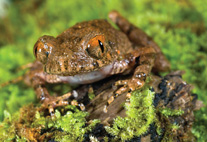Abstract
We describe a new, medium-sized Leptolalax species from the Kon Tum Plateau of Vietnam and adjacent Cambodia. Leptolalax isos sp. nov. is distinguished from its congeners by a combination of an absence of distinct dark brown/black dorsolateral markings; toes with rudimentary webbing, wide lateral dermal fringes in males and weak or absent lateral dermal fringes in females; most males with wide lateral dermal fringes on Finger II, a body size of 23.7–27.9 mm in 38 adult males and 28.6–31.5 mm in 9 adult females, near immaculate white chest and belly; absence of white speckling on the dorsum; and a call consisting of 2–3 notes with a dominant frequency of 5.9–6.2 kHz (at 22.4–22.8º C). Uncorrected sequence divergences between L. isos sp. nov. and all homologous 16S rRNA sequences available are >10%. At present, the new species is known from montane evergreen forest between ~650–1100 m elevation in northeastern Cambodia and central Vietnam. Habitat within the range of the new species is threatened by deforestation and upstream hydroelectric dams.

